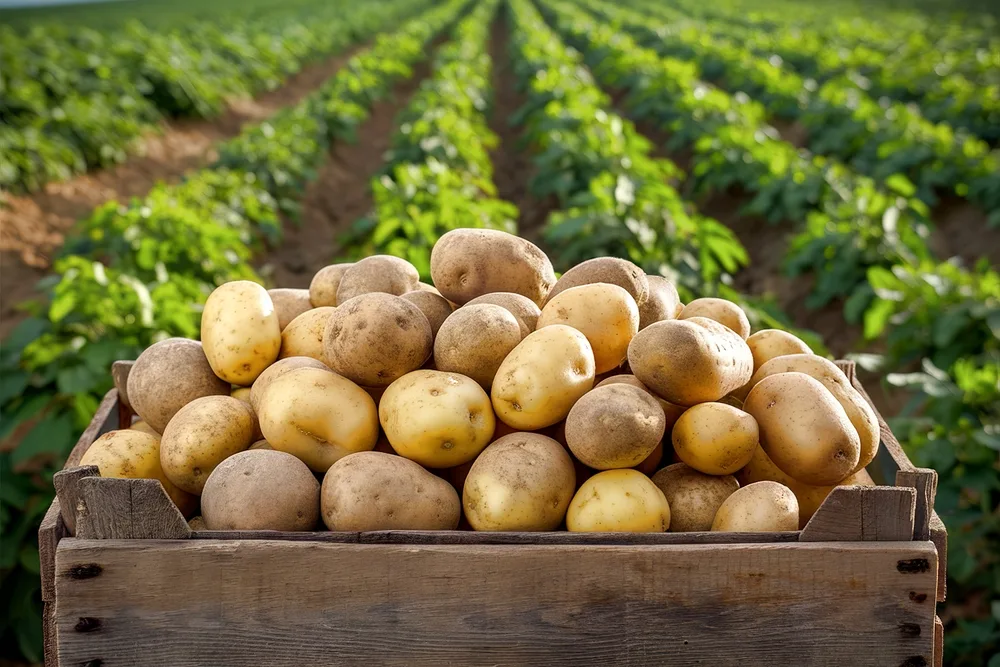All potatoes from the garden are typically harvested late in the growing season, but the timing of harvest depends on how you intend to use them.
New potatoes, meant for immediate consumption, are harvested earlier than those intended for long-term storage.
Potatoes, like all root crops, are best harvested by digging them up. They can be easily bruised, so handle them carefully, especially if you plan to store them.
When to Harvest Potatoes

After planting seed potatoes in cool, frost-resistant weather (they can tolerate light frost), they need several cool days before harvesting.
The best time to harvest depends on the flowers and foliage. Harvest new potatoes two to three weeks after flowering ends, and mature potatoes two to three weeks after the foliage dies back.
Harvesting New Potatoes
New potatoes are small and tender, meant to be eaten right away as they do not store well. When the plants finish flowering, gently dig around the plant edges with a garden fork to lift the cluster of potatoes.
Using a garden fork reduces the risk of cutting the tubers compared to using a shovel. Typically, potatoes lie 4 to 6 inches deep in the soil. Smaller potatoes can be left in place and replanted gently to continue growing.
Although new potatoes are usually eaten immediately, they can be stored for a few months, though not as long as fully ripened, cured potatoes. Store them in a dark place at 38 to 40 degrees Fahrenheit.
Harvesting Mature Potatoes for Storage
To harvest large, mature potatoes for storage, allow the plant to grow after flowering. Keep adding soil or mulch around the plants to protect the tubers from sunlight. Once the top foliage has died back, use a garden fork to dig up the tubers.
The ideal time for harvest varies by potato type and your local growing conditions, typically in August or September.
If the plants are killed by frost above ground, it won’t affect the tubers immediately, but leaving them in the cold ground too long can cause freezing. Harvest shortly after foliage dies back.
Potatoes grown in containers may be ready earlier due to warmer soil, but the cue to start harvest is the same—wait until the foliage dies back.
Checking Ripeness and Storage
Check potato ripeness by rubbing the skin with your thumb. Fully ripe potatoes will have skins that don’t rub off easily. If harvested too early, they’re considered “new” and should be eaten soon.
Mature potatoes can be washed and eaten right away, but for storage, avoid washing them.
Let them sit in a shaded spot in a single layer for a couple of weeks to cure fully. Brush off dry soil and store in a cool, dark place at 38 to 40 degrees Fahrenheit. Keep them dry; refrigerators aren’t suitable.
Discard potatoes with damaged skins or use them promptly; they won’t store well. Fully cured and ripened potatoes can last several months. Avoid exposing them to light during curing and storage to prevent greening.
Saving Potatoes for Replanting
Save some potatoes as “seeds” for spring planting. Three to four weeks before planting, place seed potatoes in a warm, sunny area covered with moist burlap or paper towels. Green shoots will soon sprout from the eyes.
When planting time arrives, cut large potatoes into two-ounce pieces, each with a sprout. Let them sit cut side up for a few days to form a protective skin.
Once the cut side darkens, plant the pieces with the sprout facing up. Each segment will yield a hill of potatoes in a few months.
